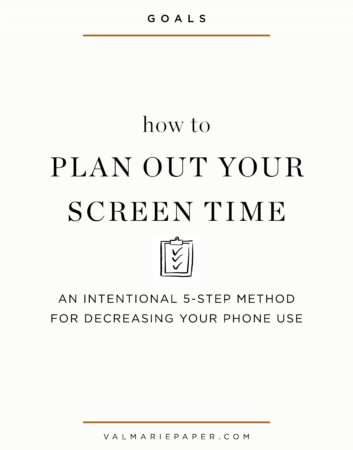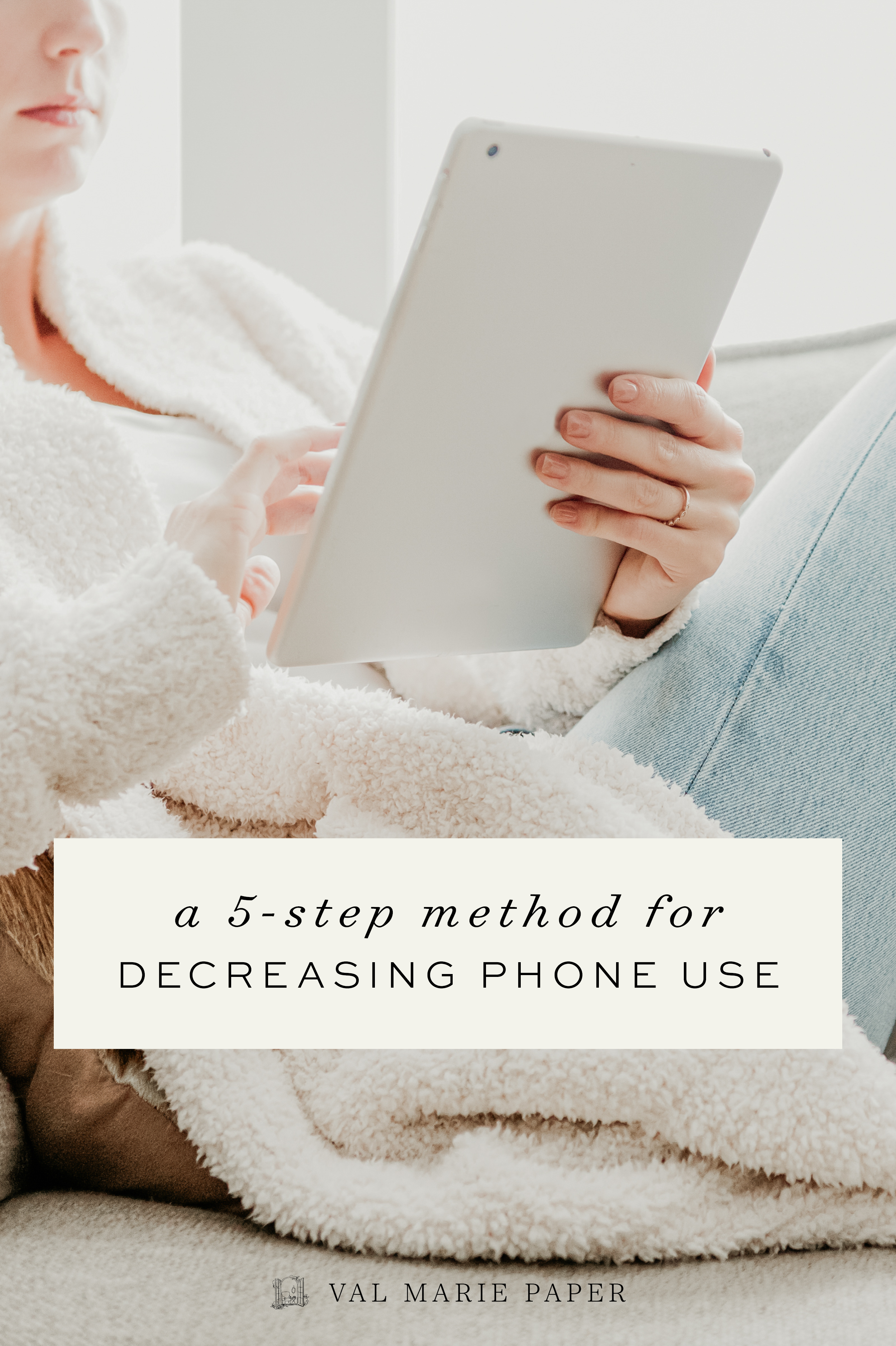After last week’s blog post on how I’m using my phone less and our discussion on Instagram, I talked to so many of you who were struggling to get your screen time down for very valid reasons, like living far from family, using an app at the gym or other things that we aren’t looking to cut just to beat a timestamp.
It got me thinking about how we could make changes even with really good reasons/excuses to keep using our phones. The answer? Figure out how to be intentional with the time we DO spend on it! What I’m about to share is so simple, but I’ve never seen it shared so I’m hoping it will help someone out there wanting to use their phone less but feeling like it’s impossible.
Before I talk about the planning method, I just want to share a few reasons why I think planning can help.
WE KNOW IT WORKS WITH OTHER THINGS
This is not about becoming a Nazi driven by our plan. But let’s be honest, we say if we want something to happen, we need to schedule it. We do this with workouts, Bible studies and even time with our spouses. Doesn’t it make sense to schedule how we use our phones?
INTENTIONAL PLANNING HIGHLIGHTS THE POSITIVE
If we are planning how we will spend our time on our phones, we’re highlighting the good that can happen there instead of living in a constant loop of, “I want to try to spend less time on my phone.” It can be so vague. There’s no plan, just a good sentiment that actually just frustrates us or makes us feel deprived. It’s the equivalent of finding healthy food you love instead of constantly stressing about what you can’t eat. If you know WHY you come to your phone and why you love using it, the hope is that we will spend more time on the important things instead of the mindless things that can happen on it.
THE TIME WE SAVE IS GOING TO BE WORTH THE EFFORT
If planning your screen time sounds like overkill, you can 100% ignore these tips. If you like the way life is now or the amount of time on your phone, there’s no reason to try this. But my hunch is most of us don’t want to use our phones as much as we do (I’ve literally battled this for years) and it’s worth it to make a change. If planning how you use your phone seems too cumbersome, just imagine 1 or even 2 hours less on your phone every day and what you could do with that time!
WHEN HAS MINDLESSNESS EVER WORKED?
Ok, I probably sound like I’m repeating myself but let’s look at this another way. When have we ever been OK with mindlessly doing anything? We want to be aware of the decisions we make, intentional and even prayerful. We’ve come to accept the idea that our phones are a place we can unwind and zone out in hopes of refreshment but the most refreshing things I’ve ever done have been intentional.
Hopefully, I’ve convinced you that what I have below, as simple as it may seem, is totally worth trying if you struggle to figure out how to spend less time on your phone.
1. Assess why you use your phone.
Name everything. Look at the apps you use and write out all the reasons you pick up your phone to begin with. Your list may include things like texting friends, using slack to interact with my team at work, counting macros, posting to social media, actually calling people ;), using my Bible app.
2. Rank them in priority.
If you live far from family, texting or Voxer may be your top priority. If you’re going through a plan on YouVersion app, that’s gonna be high on your list. Having a list of what’s a priority is going to be really important on days when we need to figure out what to cut back on when we’re close to our limit for the day.
3. Map out how much time they require a day/week.
Be realistic here. If you run a business, Instagram will likely be on there as something you need to use daily or weekly but I promise, 95% off businesses can do just fine spending 30 minutes a day or less on the app. This is an important step because it’s really easy to convince ourselves we NEED to spend time doing something when what we’re allowing for is hours of scrolling that doesn’t serve us, our business or our customers. This step will help you get intentional on the apps you do need to use consistently.
4. Plan it for the week.
Ok, don’t get crazy here, but have a loose plan that you write down, maybe in your planner, of when you’ll be required to use your phone. It could even include things that are small but ALWAYS happen and you aren’t looking to cut them out (See my Tuesday 😉 ):
Monday Screen Time:
Gym workout – 45 minutes
Insta Live – 20 minutes
Tuesday Screen Time:
GPS – 15 minutes
Post-Bachelor dish with Kari – 30 minutes
Read Val’s new blog post 😉 – 15 minutes
What do you do with this info?

5. Fill in the gaps intentionally.
We’re gonna use our phones more than what’s planned, but when we know what’s planned, we can choose wisely. Like maybe if Tuesday is a busy day on your phone, you don’t look at Instagram that day? Literally, delete it from your phone Monday and don’t add it back till Wednesday. I’ve had to start using social media on my phone only on Monday, Wednesday and Friday because it can be time-consuming even though it is great for VMP. If I was on there every day, I don’t think I’d be able to hit my goal of 2 hours or less every day. On MWF, I know to be more intentional knowing that will take a good chunk of my time.
BONUS TIP: Use a less addictive device.
This is going to sound like cheating, but it actually helps! Technically, I can still view Instagram on my computer Tuesday and Thursdays, but because I plan my work time, I am pretty good about hopping on to grab that link I needed or respond to a comment without it turning into the timesuck it would be on my phone. I also use my iPad, which doesn’t have social media during my quiet times to use my Blue Letter Bible and YouVersion app. If it’s possible to only view FB online and you know it’s less likely you’ll scroll for an hour on your computer, do it. The phone is easy because we can pick it up at a moment’s notice and use it without drawing too much attention to ourselves like lugging out a laptop would be.
This approach will likely sound really over the top to some but it forces us to get really honest about what’s actually necessary in life and what’s not. It’s really easy to convince ourselves we’re “working” or being productive when we really already found what we needed for work and then scrolled for 15 minutes. We can’t change our behaviors if 1) we don’t believe change is possible 2) we don’t know what our behavior actually is. This method makes us aware of both! I hope it helps!
Give it a try for one week and see what happens! Then come tell! 🙂




Leave a Reply
Comments (0)